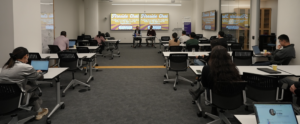LinkedIn LinkedIn LinkedIn Meet 2023-24’s Women in Transportation The Women...
Read MoreWhy do women pay more in transportation costs than do men, and what can we do about it? C2SMART researchers & staff were proudly part of the advisory team for this amazing ideation workshop series on the #PinkTax on Mobility https://t.co/tI83k5OhNd
— C2SMART (@c2smartnyu) February 16, 2022
As part of C2SMART’s Future of Mobility project, Principal Investigator Sarah Kaufman has been leading research into the gender equity gap in transportation. She recently co-led the release of a white paper which outlines a clear definition of the “Pink Tax on Mobility”, as well as opening the door to innovations which can alleviate this problem. The recently released white paper was borne from research and a workshop held in 2021, facilitated by C2SMART and other project partners, to frame the issue for various stakeholders, lay the foundation for systemic change, and gather momentum by identifying high-impact near-term interventions.
“The Pink Tax” refers to a form of gender-based price discrimination concerning the upcharge women pay for specific products or services. Although the term is most frequently referenced in regard to cosmetic and personal care products, it is also prevalent in transportation services: while women do not explicitly pay higher prices for the same rides, they are often subject to paying more for safer modes of transportation, missed opportunities for work that would require travel late at night, or the added time burden of transporting dependents.
“Understanding the Pink Tax and how to eliminate it is increasingly urgent during this transition to avoid unintended consequences around personal
safety and gender equity,” says Kaufman, whose first report on the Pink Tax was released in 2018.
“The sources and impact of—as well as potential solutions for—the Pink Tax are complex and far reaching. Disproportionate caregiver responsibilities and heightened concerns for personal safety reflect broader social issues, and the transportation inequities in turn reflect workplace policies and biases, criminal justice practices, and lasting infrastructure design issues. These long-standing challenges are further exacerbated by the global health pandemic and the national racial equity movement. Addressing the Pink Tax is more urgent than ever, and it is critical to start now.”
The newly-released whitepaper is intended to frame the issue for various stakeholders, lay the foundation for systemic change, and gather momentum by identifying high-impact near-term interventions. To that end, seven breakthrough concepts were identified:
1. Incident reporting: simplify the reporting process
and explore app-based services.
2. Shared micromobility designed for women’s
travel needs: expand fleets with new designs to accommodate bags and packages, with deployment
focused on off-peak and shorter range trips.
3. Inclusive trip planning: account for safety considerations in trip planning software.
4. Station-specific applications: engage local communities to crowdsource concerns and create custom-tailored solutions.
5. Gender audit tool: include a gender-lens review to
score transit projects moving forward.
6. Responsive lighting and accessible announcements: ensure announcements are made in auditory and visual form to improve safety and usability
for people with disabilities.
7. Family fares: develop a singular payment option
for families to ease cost burdens for caregivers.
C2SMART remains committed to furthering research and work to promote equity and accessibility in transportation.
Related Posts
6th Annual Women in Transportation Panel
March 11, 2024 To celebrate Women’s History Month, C2SMARTER, the...
Read MoreCUNY City Tech/NYU C2SMARTER Poster Presentation & Social
March 5, 2024 In early March, C2SMARTER’s NYU contingent hosted...
Read MoreStudent Learning Hub: Fireside Chat with Chris Wichman of Airsage
February 21, 2024 On Wednesday, February 21, C2SMARTER hosted a...
Read More




